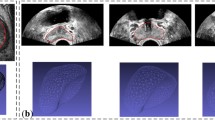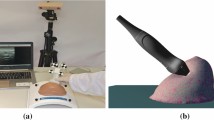Abstract
A direct approach to using finite element analysis (FEA) to predict organ motion typically requires accurate boundary conditions, which can be difficult to measure during surgical interventions, and accurate estimates of soft-tissue properties, which vary significantly between patients. In this paper, we describe a method that combines FEA with a statistical approach to overcome these problems. We show how a patient-specific, statistical motion model (SMM) of the prostate gland, generated from FE simulations, can be used to predict the displacement field over the whole gland given sparse surface displacements. The method was validated using 3D transrectal ultrasound images of the prostates of five patients, acquired before and after expanding the balloon covering the ultrasound probe. The mean target registration error, calculated for anatomical landmarks within the gland, was 1.9mm.
Preview
Unable to display preview. Download preview PDF.
Similar content being viewed by others
References
Kirkham, A.P., et al.: How good is MRI at detecting and characterising cancer within the prostate? Eur. Urol. 50, 1163–1174 (2006)
Byrne, T.E.: A review of prostate motion with considerations for the treatment of prostate cancer. Medical Dosimetry 30, 155–161 (2005)
Morgan, D., et al.: Registration of preoperative MR to intraoperative ultrasound images for guiding minimally-invasive prostate interventions. In: Proc. MIUA, pp. 181–185 (2007)
Chi, Y., et al.: A material sensitivity study on the accuracy of deformable organ registration using linear biomechanical models. Med. Phys. 33, 421–433 (2006)
Mohamed, A., et al.: A combined statistical and biomechanical model for estimation of intra-operative prostate deformation. In: Dohi, T., Kikinis, R. (eds.) MICCAI 2002. LNCS, vol. 2489, pp. 452–460. Springer, Heidelberg (2002)
Alterovitz, R., et al.: Registration of MR prostate images with biomechanical modeling and nonlinear parameter estimation. Med. Phys. 33, 446–454 (2006)
Bharatha, A., et al.: Evaluation of three-dimensional finite element-based deformable registration of pre-and intraoperative prostate imaging. Med. Phys. 28, 2551–2560 (2001)
Crouch, J.R., et al.: Automated finite element analysis for deformable registration of prostate images. IEEE Trans. on Med. Imag. 26, 1379–1390 (2007)
Tanner, C., et al.: Factors influencing the accuracy of biomechanical breast models. Med. Phys. 33, 1758–1769 (2006)
Taylor, Z.A., et al.: Real-time nonlinear finite element analysis for surgical simulation using graphics processing units. In: Ayache, N., Ourselin, S., Maeder, A. (eds.) MICCAI 2007, Part I. LNCS, vol. 4791, pp. 701–708. Springer, Heidelberg (2007)
Davatzikos, C., et al.: A framework for predictive modelling of anatomical deformations. IEEE Trans. Med. Image 20, 836–843 (2001)
Thompson, S., et al.: Use of a CT statistical deformation model for multi-modal pelvic bone segmentation. In: Proc. SPIE Medical Imaging (2008)
Schallenkamp, J., et al.: Prostate position relative to pelvic bony anatomy based on intraprostatic gold markers and electronic portal imaging. Int. J. Radiation Oncology Biol. Phys. 63, 800–811 (2005)
Author information
Authors and Affiliations
Editor information
Rights and permissions
Copyright information
© 2008 Springer-Verlag Berlin Heidelberg
About this paper
Cite this paper
Hu, Y. et al. (2008). Modelling Prostate Gland Motion for Image-Guided Interventions. In: Bello, F., Edwards, P.J.E. (eds) Biomedical Simulation. ISBMS 2008. Lecture Notes in Computer Science, vol 5104. Springer, Berlin, Heidelberg. https://doi.org/10.1007/978-3-540-70521-5_9
Download citation
DOI: https://doi.org/10.1007/978-3-540-70521-5_9
Publisher Name: Springer, Berlin, Heidelberg
Print ISBN: 978-3-540-70520-8
Online ISBN: 978-3-540-70521-5
eBook Packages: Computer ScienceComputer Science (R0)




